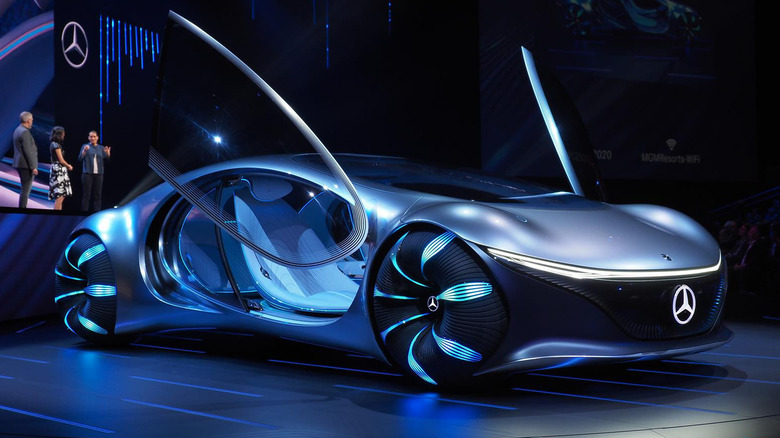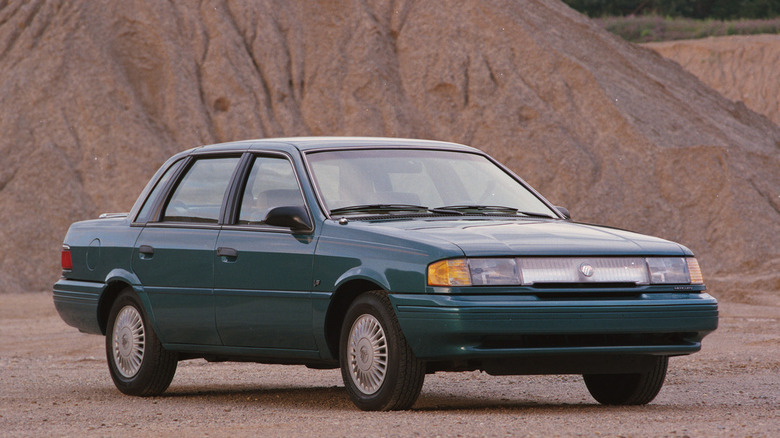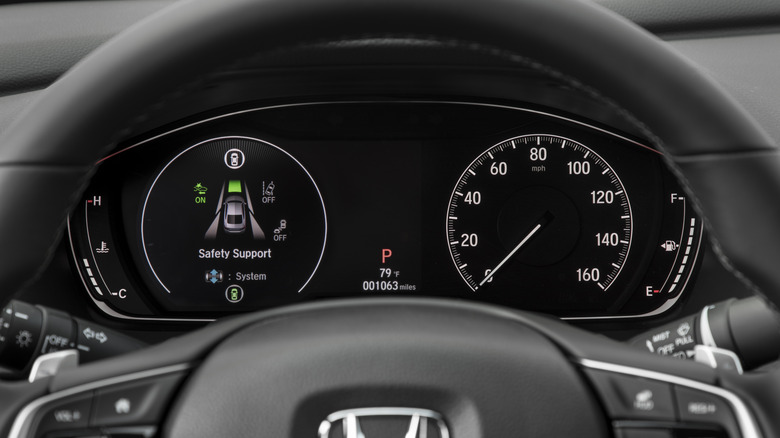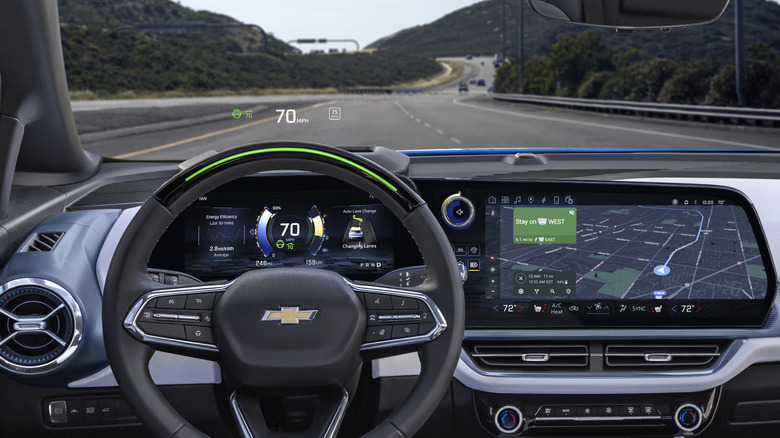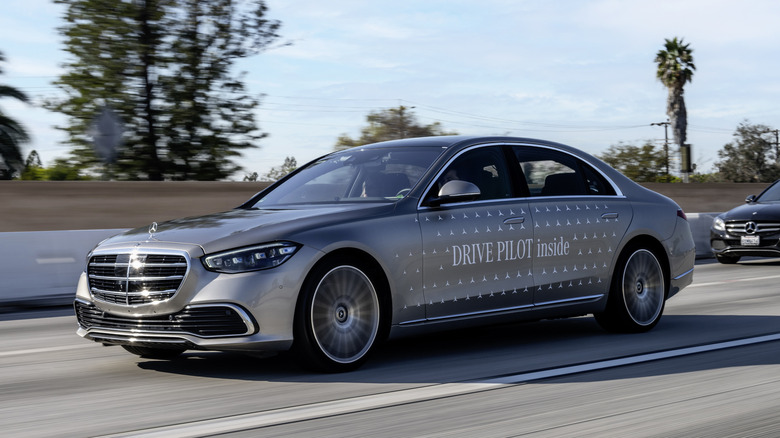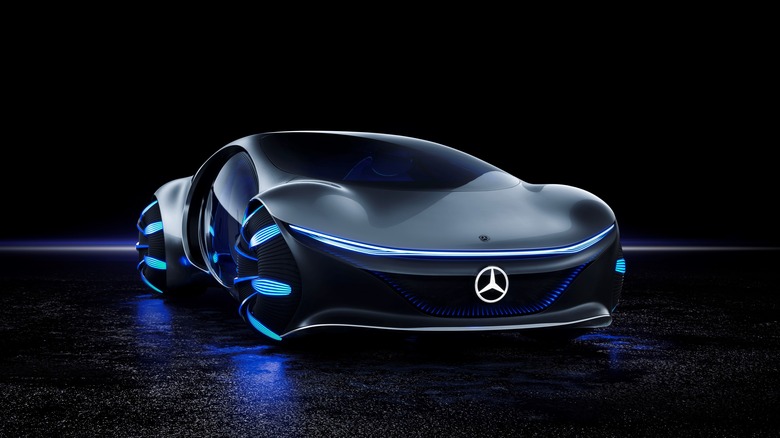Everything You Should Know About The 5 Levels Of Autonomous Driving
Autonomous driving has been part of the discussion since the advent of motorized transportation, and it's seeming always "just around the corner." But as new cars do their best impression of a supercomputer on wheels, true autonomous driving technology is creeping (albeit very slowly) closer and closer to a reality that the average person will get to experience. Systems like BlueCruise from Ford and Super Cruise from General Motors possess fairly advanced capabilities when it comes to the vehicle making "decisions" for itself, even if they're not officially "fully autonomous" in the process.
Mercedes-Benz has made recent great strides in autonomous driving technology with its Drive Pilot system. Drive Pilot, like the aforementioned BlueCruise is an active driver assistance system that allows the car, in this case certain models of the Mercedes S-Class and EQS Sedan, to "drive itself" in a limited way. In early 2023, Drive Pilot became the first Level 3 autonomous system to get U.S. approval. But what does that mean with regards to autonomous driving as a whole? And why is that important?
Autonomous driving levels and you
Though there's no universal "official" definition for just what a self-driving car is, or isn't, there is at least a fairly broadly acknowledged one. The Society of Automobile Engineers (SAE) International has published a list of criteria for six levels of autonomous driving, starting with Level 0 and ending at Level 5. Level 0 classifies regular everyday driving with no or very limited autonomous features, and Level 5 is reserved only for a vehicle that drives itself completely without human control.
Starting with Level 0, vehicles with this classification are regular cars that most people have in their driveway right now. This level includes features like blind spot monitoring, lane departure warning systems, and automatic emergency braking systems, which have proliferated in mass-market vehicles over the past few years. Basically, if your car is yelling at you to do something like stay in the lane but doesn't intervene, then it's a Level 0 car. This level has been present since humans first started driving without the assistance of a horse or other beasts of burden.
Level 1 features
At Level 1, a car is starting to make very limited decisions for itself. This level, according to the SAE, includes features that steer, brake, or accelerate the car without user input. You'll see this in increasingly commonplace features like automatic lane keep assist and adaptive cruise control. With these capabilities, the car is "deciding" — through an array of sensors — to stay centered in a particular lane on the highway, or to keep a certain distance between the car and other vehicles in traffic while going highway speed.
It's important to note that, in order for a car to be classified at Level 1, it has to have at least one of the aforementioned features but not both simultaneously: that would classify it a higher level on the list. Level 1 features have been around for a few decades and vehicles have been using either laser or radar guided cruise control since at least the late 1990s (via Toyota)
Level 2 driver support features
In 2023, Level 2 technology is starting to come into its own. Per the SAE, Level 2 support features include the same capabilities as Level 1, but the organization stipulates that the systems must be working together. Ford's BlueCruise, GM's Super Cruise, and Tesla's Autopilot are considered Level 2 support systems; so too is Hyundai's HDA. The driver is still in complete control of the vehicle at all times, but features like lane-keeping and adaptive cruise control ideally help offload the driving burden somewhat and, as a result, make driving less stressful. It can be immensely convenient during long drives, and can help keep you and other drivers safe when the systems step in to prevent an accident.
Level 2 systems are just about the absolute pinnacle of what a normal driver may be able to purchase today. As cars become more connected and advanced (especially during the transition to electric vehicles), Level 2 features will likely become commonplace within the next few years. Already, multiple manufacturers have released some form of a Level 2 support system in their new cars, though it's important to remember that they don't count as true self-driving vehicles.
Indeed, the SAE stipulates that levels 0-2 are considered "driver support features" and are not therefore "automated" features. Whether they track attention by a hand on the steering wheel, or by monitoring the driver's eyes to ensure they're looking at the road ahead, Level 2 systems are always poised to hand back control to the human in the driver's seat. That's something the driver needs to be ready for.
Level 3 automated features
At Level 3, the car is, for all intents and purposes, "driving itself" just in a very limited way. The driver is still in the driver's seat, but the car may stop, start, and even change lanes in traffic depending on what its sensors are telling it, not necessarily what the driver is doing. This does not mean, however, that you can doze off while you have your own robot chauffeur drive you around. You still need to be prepared to retake full control of the car if necessary, typically when it leaves the conditional circumstances its Level 3 system is designed to handle.
Level 3 is just in its infancy and the technology is still developing. With the Drive Pilot feature enabled, for example, a compatible Mercedes-Benz can navigate through traffic — as long as it's under 40 miles per hour, during daylight hours, and on select pre-mapped sections of highway — and even call emergency services if it detects that the driver is unresponsive. Outside of those conditions, however, Drive Pilot will handoff control to the human driver. Only a small number of U.S. states are giving the green light to the technology, and the first Mercedes vehicles to offer it will go on sale in the second half of 2023.
Level 4 and 5: The future
Level 4 and 5 vehicles are entirely autonomous, though with a few clear differences. With Level 4, a car is completely capable of driving itself within a certain setting, according to the SAE. This would include autonomous taxi services where a driver may not even be present, and "driver-less" cars where a brake/accelerator pedal — and even a steering wheel — may not be present at all. As of now, there are no commercially available Level 4 systems — though companies like Cruise and Waymo are offering limited robotaxi services in select U.S. locations — while, despite the hyperbolic name, Tesla's "Full Self-Driving" feature absolutely does not qualify as a Level 4 or even Level 3 system.
Level 5 systems are firmly within the realm of science fiction, far-out concept cars, and design studies for the moment, as that tier covers vehicles that are capable of navigating themselves anywhere, without any kind of driver input, in any setting. In short, they would be completely autonomous and require no driver input at all to control the car, beyond perhaps specifying a destination. A particularly disobedient horse technically qualifies as a Level 5 autonomous vehicle, as it is capable of making decisions by itself without rider input, but it seems likely that the auto industry will take a little longer to catch up.
